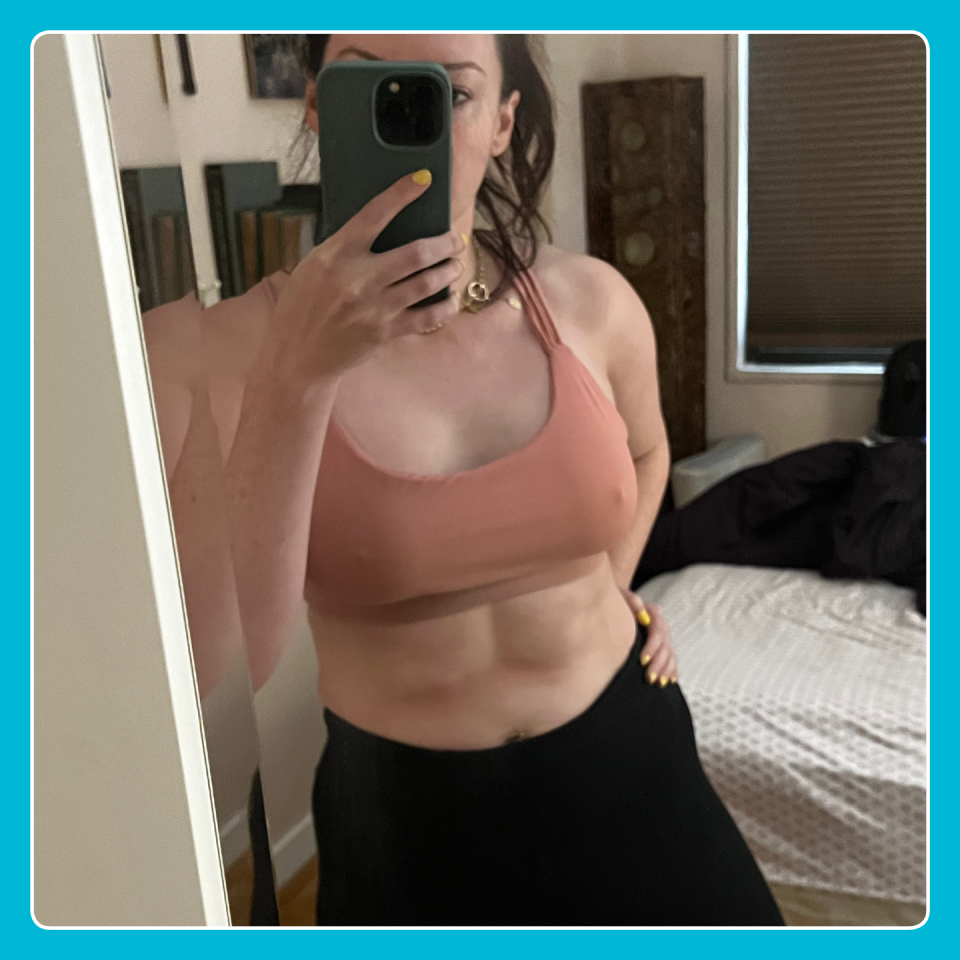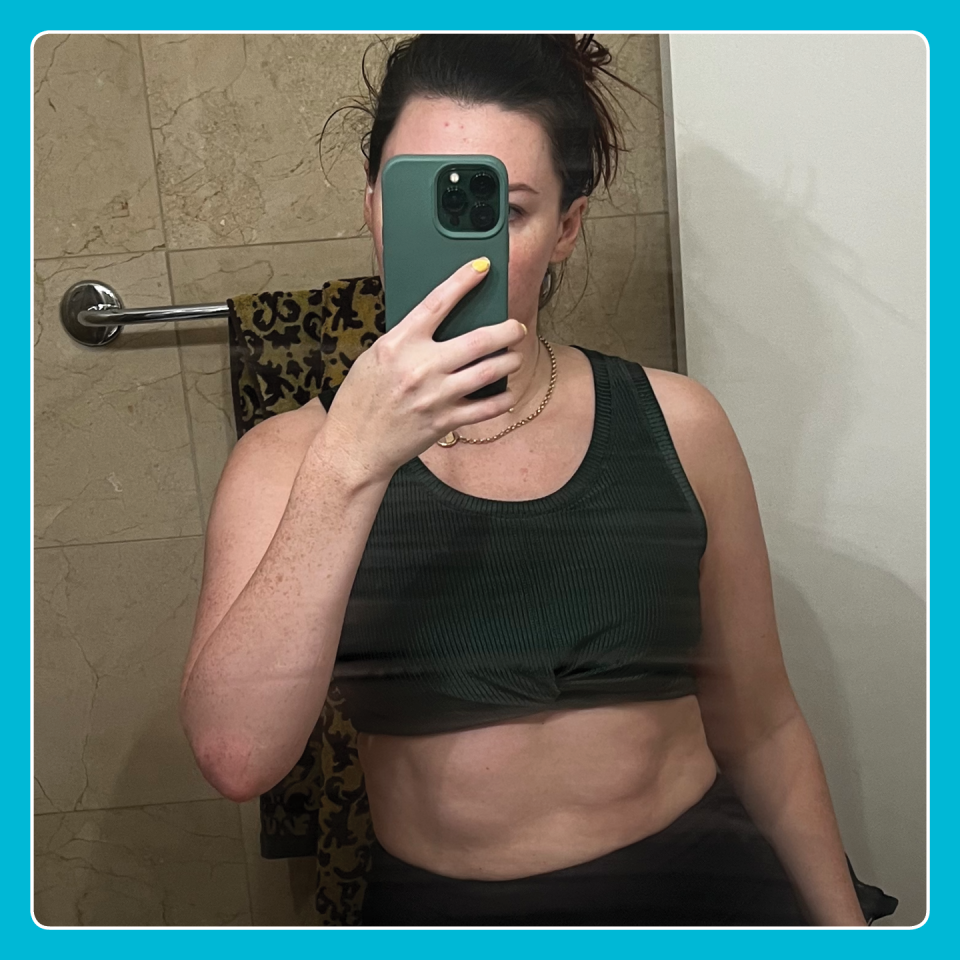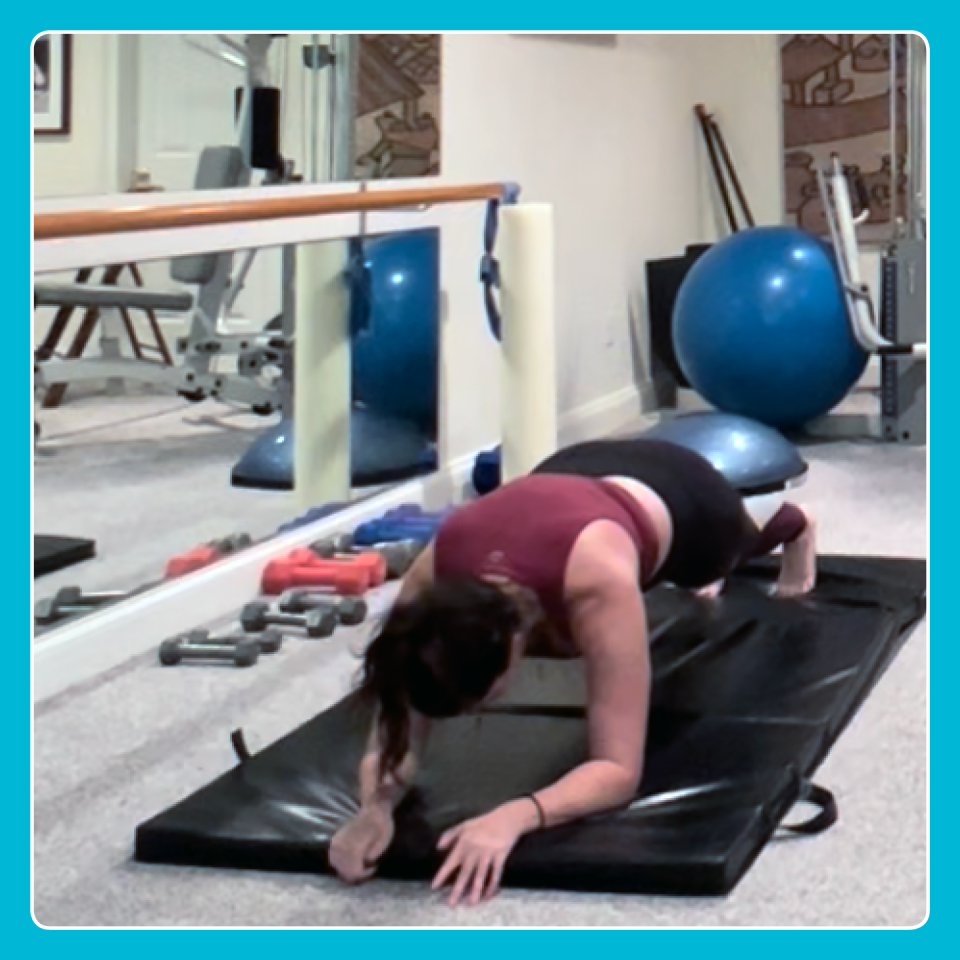‘I Did Plank Variations Every Day For A Month—And My Core And Arms Are Stronger Than Ever’

I don’t love planks. There I said it. Isometric exercises (or holding one position) are not my thing. I prefer other types of core exercises (hi dead bugs, bicycle crunches, inchworms, or V-ups!) over a plank hold any day.
The thing is, I do like to move. And maybe I wasn't giving the good ol' stationary plank enough credit up until this point. Planks are generally regarded as one of the best core (and total-body) exercises you can do, so I was excited and nervous to embark on a 30-day plank challenge.
“The plank is one of the best exercises you can do for your core because it activates your entire core, including your pelvic floor muscles, your obliques, rectus abdominis, transverse abdominis, and your spine,” says Amanda Edell, NASM- and ACSM-certified online personal trainer and holistic health coach.
I accepted the plank challenge—one plank workout every single day for a month—to see how it would make me feel and perform. It was a fun fitness goal to add into my regular sweats. Here are the exact workouts I did and what happened to my abs and mindset throughout the 30 days.
The Workout Challenge: Complete A Plank Every Day
My goal for this challenge was to start off slow, refine my form, and progress throughout the month. I looked to these plank-optimizing tips to begin my journey and went back to basics to gauge my plank abilities. The optimal plank hold is a totally reasonable 60 seconds. (Yep, really!)
The Workout Plan
DAYS 1-5: High plank – 10 seconds on, 10 seconds rest, for 6 sets
DAYS 6-7: High plank — 45 second planks on, 45 seconds rest, for 3 sets
DAYS 8-12: High plank — 60 second planks on, 60 seconds rest, for 3 sets
DAYS 13-15: Plank variations (mountain climbers, push-ups, and side planks)— 20 seconds on, 10 seconds rest, for 2 sets
DAYS 16-30: Advanced plank variations (side planks, planks with shoulder taps, and plank up-downs)
You should only hold a plank as long as you can keep tension while maintaining your alignment. “Sixty seconds or more and your tension is probably not the same as it was when you started the plank,” says Kevin Dineen, CEO at Structure Personal Fitness in New York City. “Ideally, do three sets of more tension and less time.”
Week one: I felt the daily planks in my lower abs and arms.
I started with a simple set of high planks in the evening after a grueling work day. I focused on really engaging my abs. As an avid workout enthusiast I didn’t find it overwhelmingly challenging, but I definitely felt it. I like that it was quick and easy and I didn’t have to break a sweat to fit it in.

The first week of the plank challenge wasn't all easy, though. I encountered a few struggles. Surprisingly, I felt extra stress on my shoulders and wrists. With no rest days, it was increasingly challenging on my upper body. (Proof planks are so much more than core.)
The perks showed up early, too. By day five, I started to really feel the burn in the lower belly, which I usually find more difficult to target. My endurance also improved quickly. By the end of week one, my workout included three sets of 45-second planks, with an equal amount of rest time in between. (BTW, that's double the total plank time I started with on day one!)
Week two: I stayed consistent and saw real progress.
It didn't take long before I hit the optimal high plank hold time of 60 seconds. My shoulders and wrists were almost keeping up with my newfound abs endurance. I focused on maintaining form and dropped to a forearm plank to finish some sets.

By the end of week two, I started incorporating more advanced plank variations into my routine. I experimented with mountain climbers (demoed below) and plank saws. I was shocked at how quickly two weeks went by and wanted to continue improving my core and overall strength.
I was so stoked, I extended what was originally a two-week plank challenge to a whole month of planks. Who is this budding pro planker?
Week Three: Plank workouts became more of a mental challenge.
Unfortunately my enthusiasm didn't last long. Planks get boring after two weeks. (I mean reeeally boring.) There's a special type of mental challenge that sets in after doing the same static exercise every day for three weeks. The boredom factor was more exhausting than the physical challenge.
So, I switched things up as much as I could with more difficult plank variations with shorter intervals. One sesh included two mountain climbers followed by knee push-ups for 20 seconds, with a 10-second rest in between for two sets. Then, I did two sets of 20-second side planks on each side, with a 10-second rest in between.
Week four: Focusing on form and plank variations helped me complete the challenge.
What little plank optimism I had starting week three definitely was dwindling. No matter what I did, planks were just plain boring. To push through the finish, I added more plank variations into my routine. I did side planks, planks with shoulder taps, and even some plank up-downs. How long I held them didn't matter as much as simply completing the challenge. I was so close to a plank-free life.
I finished off my last day going back to basics. I did three sets of high planks, holding for 30 seconds on, with 30 seconds of rest in between.

My Biggest Takeaways
It takes a full two weeks to notice a change in core strength.
For a plank challenge, 15 days is the sweet spot. At this point I saw and felt progress, but I wasn't bored. I think like any type of exercise, if you genuinely enjoy it, you’ll stick to it.
I'll be honest, by the end of the month, I was dreading working out just because I knew I had to do more planks. I need more variety to keep me excited about sweating, and the planks were the exact opposite. Physically I could perform them, but the monotony was dull.
I am super proud of myself for completing the fitness challenge through all the struggles. It’s been a long time since I’ve done any sort of physical challenge and accomplishing a goal was extra sweet.

It’s okay to have off days.
Without really giving my body time to rest and recover, some days were more difficult than others. I learned that’s okay and found ways to adjust instead of throwing in the towel.
With the trainer's tips echoing in my head, I finished sets on my forearms. I’d rather modify than sacrifice my form and potentially get injured. “Remember the most important thing is to maintain form. So if you feel like your form is breaking down, cut it short,” Edell reminds us.
Planks helped me improve at *other* core work, too.
I felt significantly stronger when I returned to my usual abs workouts. My newfound core strength helped me rock advanced moves I previously found challenging. When I did Pilates V-holds a few days later, I didn’t really even break a sweat.
I still don't love planks but I'll keep them in my routine along with a whole bunch of other abs moves. “Suitcase, farmers, or racked carries are a great way to increase weight-bearing exercises and teach tension without excess complexity, shoulder, or wrist worries,” Dineen says. I'm excited to incorporate these and other core exercises in my routine.
I realized the importance of proper form and saw a big boost in mine.
In the middle of the challenge, I really focused on my form. One major benefit of doing the same move on repeat was dialing in proper technique. I had time to think through and pay attention to what all my muscles (abs, shoulders, butt, and more) were doing.
I also noticed when my form faltered and I needed to back off. I let my bod tell me what it needed, like giving my shoulders and wrists a rest.
Bottom line: I learned I can accomplish anything I set my mind to—and so can you! I also realized it's important to do workouts that I enjoy. If it’s not bringing joy, it's time to switch it up and find something that does.
You Might Also Like